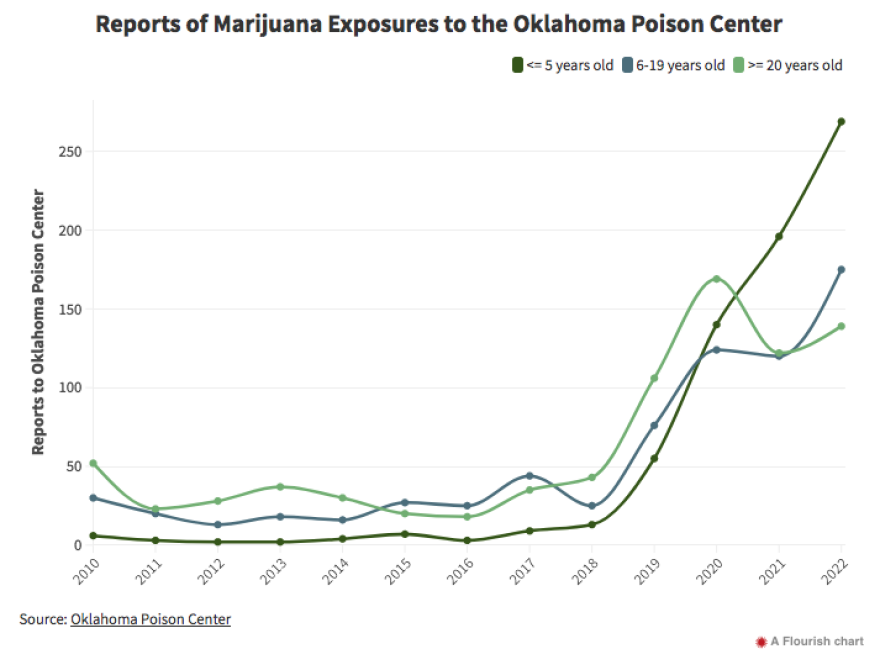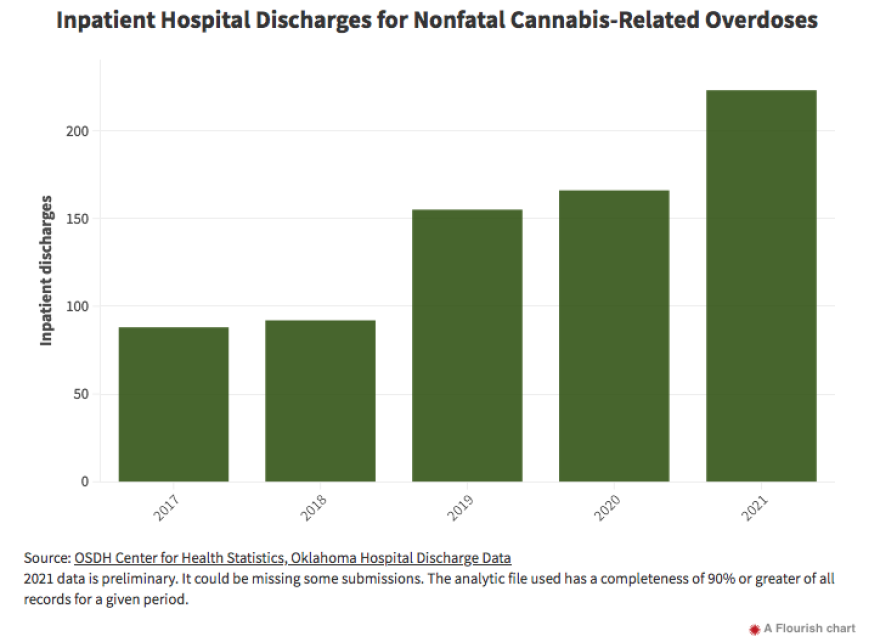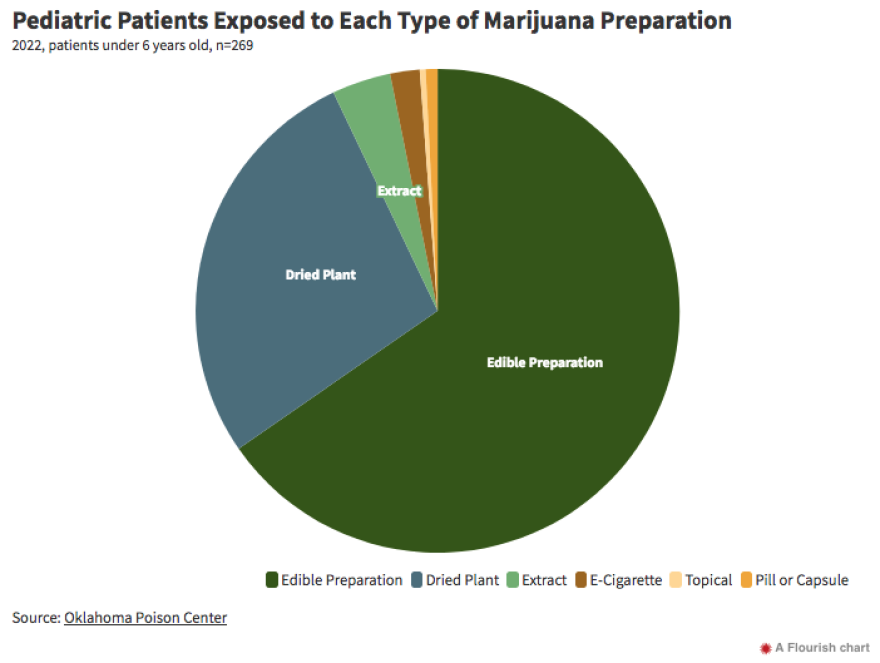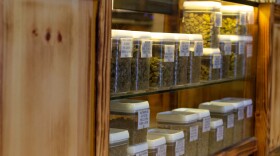In 2022, 583 cases of accidental marijuana consumption were reported to the Oklahoma Poison Center. Almost half involved a child under 6 and most involved edibles.
Accidental consumption and overdoses rose dramatically in Oklahoma after the state legalized the drug for medicinal use in 2018. According to data from the Oklahoma State Department of Health, there was a 253% increase in discharges from Oklahoma hospitals for marijuana overdose between 2017 and 2021.
Packaging for edible products tends to be appealing to children, particularly because it often looks like candy, said Annette Jacobi, the executive director of the Oklahoma Commission on Children and Youth, in an interview with Oklahoma Watch. Edibles also tend to lack the same child-proof packaging other medical products have.
National organizations are taking some steps to address packaging. In early July, the Federal Trade Commission and the Food and Drug Administration jointly sent cease and desist letters to six companies selling marijuana edible products labeled to mimic common snacks like Doritos and gummy bears.
Marijuana overdoses can trigger changes in heart rate and visual, muscular and mental difficulties, making people slow to react and confused by their surroundings. In young children, consumption of marijuana can also cause temporary a lack of muscle coordination, lethargy and seizures.
Accidental marijuana consumption has steadily risen nationally since 2016, according to a 2021 report by America’s Poison Centers.

However, aspects of Oklahoma’s medical marijuana market differ from other states. For instance, the supply-to-demand ratio of marijuana in the state is 64 to 1, according to a June report by the Oklahoma Medical Marijuana Authority, despite demand for marijuana products being on par with other states.
The Oklahoma Medical Marijuana Authority’s response to the report included a multi-pronged approach to the problem, including a goal to improve the monitoring and regulation of purchases of medical marijuana products through increased use of technological tracking systems.
Despite rising medical concerns, many Americans continue to use and promote marijuana’s medical and recreational use. National Center for Drug Abuse data shows that 72% claim regular alcohol use is worse than regular cannabis use. Three-fourths believe marijuana is not as harmful as tobacco and 67% said it is safer than prescription painkillers.
Alcohol use does pose medical dangers. The Center for Drug Abuse Statistics reported Oklahoma has an average of 12.6 annual deaths due to alcohol poisonings per 1 million citizens. As of 2023, marijuana overdose has never been listed as the cause of death in Oklahoma.
Marijuana and alcohol use has become increasingly similar in the air of “connoisseurship” in the two cultures, said Sarah Tracy, a professor at the University of Oklahoma. While some people may prefer scotch over whiskey, others may recommend an Indica variety of marijuana over Sativa.
Additionally, potencies of alcohol and marijuana have increased significantly over the decades, Tracy said.
“The marijuana today is not the same marijuana as in the 1960s,” Tracy said.

While marijuana potency has increased overall, Oklahoma’s average potency is on par with other states with medical marijuana, which usually fall around 20%, said Lee Rhoades, the chief science officer of the Oklahoma Medical Marijuana Authority. Rhoades said agencies in other states report steady growth in potency.
The rise in potency makes it even more important that limits on consumer purchasing of marijuana products are being enforced appropriately, said Adria Berry, the executive director of the Oklahoma Medical Marijuana Authority.
Licensed Oklahoma patients can have up to 3 ounces of marijuana on their person. In their residence, they can have 6 mature marijuana plants and the harvested marijuana, 6 seedling plants, 1 ounce of concentrated marijuana, 8 ounces of marijuana, 72 ounces of edible marijuana and 72 ounces of topical marijuana.
Oklahoma law also states that medical marijuana products should be treated like any other prescription drug and should be kept away from pets and children in secure packaging.
Berry said one of the goals of her agency’s new strategic response plan will be to improve monitoring patient sales and enforcing the current legal limits as well as storage safety.
Rhoades said the Oklahoma Commission for Children and Youth group is studying effective approaches to regulating medical marijuana safely and effectively. The group is working on putting together educational materials as well as preparing information for the Oklahoma state legislature.
The group is also looking into ways to improve safety for patients under 18 years old. While there is evidence small doses of marijuana are effective in treating anxiety and depression, there is medical concern that larger doses can actually worsen the conditions in teenagers.
“This is a topic, in my opinion, (that) it’s time it gets addressed,” Rhoades said.

Oklahoma Watch, at oklahomawatch.org, is a nonprofit, nonpartisan news organization that covers public-policy issues facing the state.
Copyright 2023 KGOU. To see more, visit KGOU. 9(MDA4OTAxNzAzMDEzMjc0MTc2MzA5ZDZlMw004))








